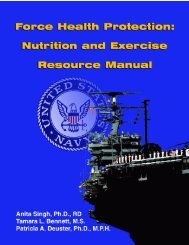Traumatic Brain Injury and Effects of Altitude - Human Performance ...
Traumatic Brain Injury and Effects of Altitude - Human Performance ...
Traumatic Brain Injury and Effects of Altitude - Human Performance ...
Create successful ePaper yourself
Turn your PDF publications into a flip-book with our unique Google optimized e-Paper software.
<strong>Traumatic</strong> <strong>Brain</strong> <strong>Injury</strong> (TBI) <strong>and</strong> <strong>Effects</strong> <strong>of</strong> <strong>Altitude</strong>:An Analysis <strong>of</strong> the LiteratureIntroductionBACKGROUND<strong>Traumatic</strong> brain injury (TBI) can occur as the result <strong>of</strong> external force due to blunt impact (being struck byor striking an object); foreign body penetration <strong>of</strong> the brain, sudden; brain acceleration or decelerationmovement; or concussive forces from an explosion or blast (see Taber et al., 2006). Depending on theseverity <strong>of</strong> the underlying injury, TBIs are classified as mild, moderate or severe. Most (75-90%) areclassified as mild TBI (mTBI) or as concussion 1 (Cassidy et al., 2004).TBI is a significant public health concern. An estimated two percent <strong>of</strong> Americans currently live with TBIrelateddisability <strong>and</strong> related costs (Rutl<strong>and</strong>-Brown et al., 2006; Thurman et al., 1999). The Centers forDisease Control (CDC) estimates that each year, 1.7 million people in the United States sustain traumaticbrain injuries (TBI). These injuries represent nearly one-third <strong>of</strong> all injury-related deaths in the U.S.annually, <strong>and</strong> are the leading cause <strong>of</strong> death <strong>and</strong> disability among young adults (CDC, 2006).Importantly, statistics reported by the CDC do not include deployed service member or veteran TBIsfrom federal, military, or Veterans Administration (VA) hospitals which face a variety <strong>of</strong> uniquechallenges associated with the diagnosis, care <strong>and</strong> treatment <strong>of</strong> TBI sustained in recent military conflicts.In cooperation with the Armed Forces Health Surveillance Center, the Defense <strong>and</strong> Veterans <strong>Brain</strong> <strong>Injury</strong>Center (DVBIC) tracks <strong>and</strong> analyzes the incidence <strong>of</strong> military TBI based on actual medical diagnoses <strong>of</strong>TBI within the U.S. armed forces. Their findings show that military TBI incident diagnoses have morethan doubled since 2005.Calendar Year 2000 2001 2002 2003 2004 2005 2006 2007 2008 2009*TBI Incident diagnoses 10, 963 11, 830 12, 469 12, 886 13, 271 12, 025 16, 873 23, 002 28, 557 27, 862* Numbers updated as <strong>of</strong> 31 December 2009.Information available at DVBIC, http://www.dvbic.org/TBI-Numbers.aspxBroadly recognized as a signature injury <strong>of</strong> conflicts in Iraq <strong>and</strong> Afghanistan, TBI is a significant concernfor the U.S. military. Head, face <strong>and</strong> neck injuries have been reported to account for 22-52% <strong>of</strong> all battleinjuries sustained by U.S. troops in Iraq <strong>and</strong> Afghanistan (Okie, 2005; Owens et al., 2008; Wade et al.,2007). In these conflicts, it has been estimated that TBI occurs in approximately 60% <strong>of</strong> blast casualties(Galarneau et al., 2008). In a recent study <strong>of</strong> soldiers deployed to Iraq, clinician-confirmed TBI history(primarily mTBI) was identified in more than one <strong>of</strong> every five (22.8%) soldiers from a Brigade CombatTeam (Terrio et al., 2009). Other studies have found that as many as 28% <strong>of</strong> military personnel havesustained at least mTBI while deployed to conflicts in Iraq <strong>and</strong> Afghanistan (Warden, 2006). As theindividual <strong>and</strong> operational costs <strong>of</strong> these injuries become increasingly obvious, so does our recognition1 In 1997, the American Academy <strong>of</strong> Neurology (AAN, 1997) identified its criteria for three grades <strong>of</strong> concussion severity. Theleast severe <strong>of</strong> these (Grade 1) is sometimes described as “minor concussion, ” but typically would not meet the diagnosticst<strong>and</strong>ards for mTBI. Therefore, the terms mTBI <strong>and</strong> concussion overlap, but are not necessarily always interchangeable.Although it is common for the two terms to be used interchangeably, it may not always be appropriate to do so in thediagnostic setting.September 14, 2010 4



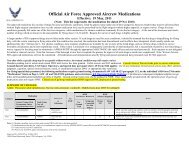

![Body Composition and Military [PDF] - Human Performance ...](https://img.yumpu.com/43269347/1/190x245/body-composition-and-military-pdf-human-performance-.jpg?quality=85)
![Tips for Grocery Shopping [PDF]](https://img.yumpu.com/37447379/1/190x245/tips-for-grocery-shopping-pdf.jpg?quality=85)
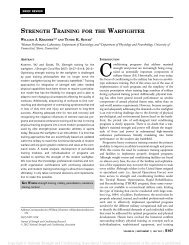
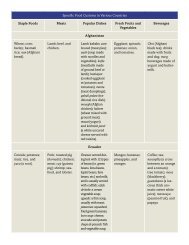
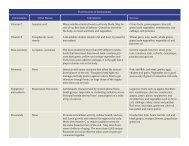
![Synthetic Drugs [PDF] - Human Performance Resource Center](https://img.yumpu.com/37447322/1/190x245/synthetic-drugs-pdf-human-performance-resource-center.jpg?quality=85)


